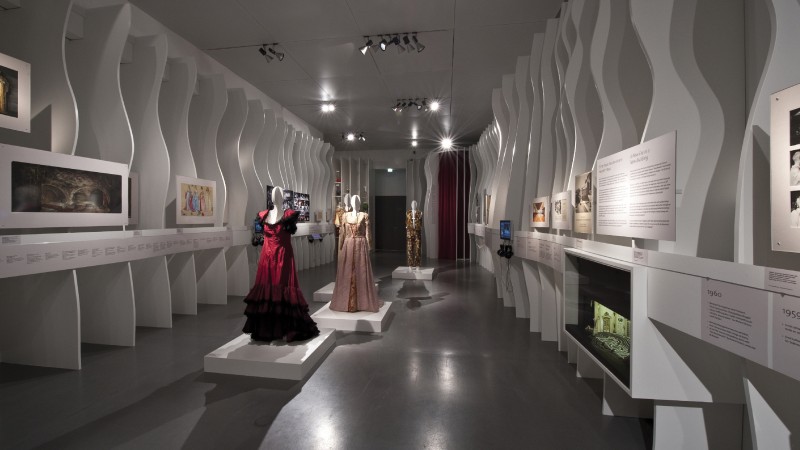In 2010, the Salzburg
Festival celebrated its 90th anniversary. A traditional style exhibition with panels, objects and models seemed inadequate
for presenting the sheer variety of artistic brilliance. Consequently, the displays and texts were "fanned out" to reflect
the scope of the Festival's history. Soundtracks and spoken excerpts from key documents in the history of the Salzburg Festival
became generators of exhibition areas, which then carried the content in the form of timber "ribs". As a result, the history
of the Salzburg Festival was physically brought into the room: visitors could not only view the events but move around in
them. The timber "ribs" were connected by a timeline that traced the development of the Salzburg Festival over the decades.
In this way, it was possible to present not only individual personalities and their work but also the connections to political
and social events, and the ambiguities, caesuras and continuities that shaped and still shape the Festival.
The
individual exhibits were placed on the surfaces of the "ribs", thereby freeing them from the restraints of the traditional,
two-dimensional form of presentation. This created "windows", opening up views into 90 years of Salzburg Festival history.
Costumes and an "Everyman" installation protruded out of the "ribs" into the surrounding space and across the visitors' path.
The high point and grand finale of the tour was the central installation of the "World Stage" - a stylised stage with
multimedia features. The media installation "The Great World Theatre" was a "meta-performance" distilled out of the leading
productions of the last nine decades and reassembled into a new presentation. The stage was an abstract model, quoting and
replicating all the stages and venues of the Festival, quite in the spirit of Max Reinhardt's motto, "The city as a stage".
The projection was devised using the so-called "augmented reality" approach: the projectors were focused onto the model, capturing
its form pixel by pixel. A different video could be played on each of the model's 22 surfaces arranged on the stage area.
July 17th to October 26th, 2010 at the
Salzburg Museum.
Client:
Salzburg FestivalArtistic direction: Virgil Widrich
Editor: Sigrid Markl
Exhibition architecture: novakarchitects
Exhibition
graphic: Robert Six/Square Union
Multimedia design: Stefan Fahrngruber
Project management: Katharina Fröch
Content
coordination: Agnes Hannes
Production: Catrin Neumüller
Videos: Günther Auer/Alexander König
Graphic website
and print Ralph Lemoch
Programming: Lukas Litzinger
Engineering: Herbert Schmitt
Technical director: Stefan
Unger
Commercial management: Stefan Reiter
Collaboration: Martin Engler, Christian Friedrich, Nicole Fleck, Katharina
Fuchs, Robert Richlik, Konradin Schuchter
Director
Salzburg
Museum: Erich Marx
President
Salzburg Festival: Helga
Rabl-Stadler
 "90 Years of the Salzburg Festival", photo: Salzburg Museum/Peter Laub, exhibition graphics: Robert Six,
exhibition architecture: novakarchitects
"90 Years of the Salzburg Festival", photo: Salzburg Museum/Peter Laub, exhibition graphics: Robert Six,
exhibition architecture: novakarchitects  "90 years of the Salzburg Festival", Architectural draft by Wolfgang Novak/novakarchitects
"90 years of the Salzburg Festival", Architectural draft by Wolfgang Novak/novakarchitects  "90 Years of the Salzburg Festival", exhibition graphics: Robert Six, exhibition architecture: novakarchitects
"90 Years of the Salzburg Festival", exhibition graphics: Robert Six, exhibition architecture: novakarchitects
 "90 years of the Salzburg Festival", photo: Salzburg Museum/Peter Laub
"90 years of the Salzburg Festival", photo: Salzburg Museum/Peter Laub  "90 Years of the Salzburg Festival – Everyman Ensemble", Stefan Fahrngruber/checkpointmedia
"90 Years of the Salzburg Festival – Everyman Ensemble", Stefan Fahrngruber/checkpointmedia  "90 Years of the Salzburg Festival", installation "The Great World Theatre", Stefan Fahrngruber/checkpointmedia
"90 Years of the Salzburg Festival", installation "The Great World Theatre", Stefan Fahrngruber/checkpointmedia
 "90 years of the Salzburg Festival", photo: Salzburg Museum/Peter Laub
"90 years of the Salzburg Festival", photo: Salzburg Museum/Peter Laub  "90 Years of the Salzburg Festival", installation "The Great World Theatre"
"90 Years of the Salzburg Festival", installation "The Great World Theatre"  "90 Years of the Salzburg Festival", installation "The Great World Theatre"
"90 Years of the Salzburg Festival", installation "The Great World Theatre"  "90 Years of the Salzburg Festival", installation "The Great World Theatre", Stefan Fahrngruber/checkpointmedia,
photo: Steinmetz, Ellinger
"90 Years of the Salzburg Festival", installation "The Great World Theatre", Stefan Fahrngruber/checkpointmedia,
photo: Steinmetz, Ellinger  "90 Years of the Salzburg Festival", installation "The Great World Theatre", Stefan Fahrngruber/checkpointmedia,
photo: levebre
"90 Years of the Salzburg Festival", installation "The Great World Theatre", Stefan Fahrngruber/checkpointmedia,
photo: levebre  "90 Years of the Salzburg Festival", exhibition graphics: Robert Six, photo: Virgil Widrich
"90 Years of the Salzburg Festival", exhibition graphics: Robert Six, photo: Virgil Widrich  "90 Years of the Salzburg Festival – Karajan Collage", Stefan Fahrngruber/checkpointmedia using material
from the Archive of the Salzburg Festival
"90 Years of the Salzburg Festival – Karajan Collage", Stefan Fahrngruber/checkpointmedia using material
from the Archive of the Salzburg Festival 



